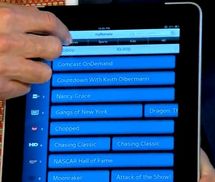Cable Show 2010: Comcast Wants To Bring 'Xfinity Remote' To DTAs
More Cable Show 2010 coverage from MCN and B&C.
Los Angeles - Comcast is showing off a Web-based remote control, running on an Apple iPad, that lets subscribers search their channel lineup and uses EBIF to send commands to their cable set-top box to change the channel or launch a VOD session.
And the operator is actively looking at how it could bring the "Xfinity Remote" functionality to its low-cost, one-way digital terminal adapters, or DTAs, according to Comcast executives. That would provide a rich, interactive program guide and remote control for the DTAs, which as currently deployed don't have the capability to display on-screen guides.
The Xfinity Remote application, which chairman and CEO Brian Roberts demonstrated during a Cable Show session here Wednesday, lets users search for shows and movies on TV and video on demand, change the channel on the cable box, and set the DVR to record remotely. It also lets someone chat with friends and can even "push" a suggestion to other Comcast subscribers using the app (e.g., "Brian has invited you to watch Gangs of New York") who can then tune their own boxes to the channel.

"This liberates us from the cable box and puts it in the power of the consumer," Roberts said in a video clip the operator posted on its corporate blog.
The Xfinity Remote is planned to be available to Comcast subs later in 2010.
The app -- which is intended to run on any Web-enabled mobile device, not just the iPad -- uses an EBIF "pairing" app on the set-top box. That shows the user a unique code, which is entered on the Web remote app, thereby linking the app with the media access control (MAC) address of the box. Channel-change commands are sent from the Web app to subscribers' set-tops via a server hosted at Comcast Media Center.
The smarter way to stay on top of the multichannel video marketplace. Sign up below.
The operator also is aiming to deliver Xfinity Remote capabilities with the DTAs it is using across all its markets to reclaim analog spectrum. Comcast to date has rolled out nearly 9 million DTAs, covering 43% of the MSO's footprint. The sub-$50 devices are designed to replicate an analog cable lineup in digital format, and they don't do much more than that.
The question is whether the DTAs could be upgraded to support the Xfinity Remote's EBIF "pairing" app. Comcast representatives were still checking into that at press time. Several cable industry executives speculated that there would probably be enough headroom in a DTA to run the EBIF user agent necessary to pair with the Xfinity Remote app and change channels.
However, an EBIF-enabled DTA might no longer be covered under the Federal Communications Commission's waiver of the integrated set-top ban, given that such a capability could be seen as "advanced."
Other operators, including Time Warner Cable, are also working to provide the same kind of remote-control capabilities via other wireless devices.
And elsewhere at the show, Silicon Valley startup Zelfy gave a presentation showing the same concept -- of a Wi-Fi-based system that would let a user with an iPod or other device find and interact with not only TV shows and VOD but also Internet video and content, as well as access social networking and e-commerce features.
The Zelfy service works with a wireless adapter that carries a bill of materials cost of about $20, said Brad Beale, Zelfy's vice president of business development. "We've been asked for a device, stripped down, that could be dedicated to that operator," he said. "All we need is Wi-Fi and a touchpad."
Beale, who previously spent 11 years at DirecTV, delivered his presentation at a panel here at Cable Show 2010, "The Next Next Thing: Inventive Ideas for Cable-Connected Technologies & Platforms," moderated by Louis Toth, Comcast Interactive Capital senior managing director.
Three other companies also made presentations: Related Content Database (RCDb), which has developed a set-top application to deliver Web services to the TV; EnergyHub, a startup pitching a device and applications for tracking energy usage in the home; and SupportSpace, which provides on-demand remote customer support services.
